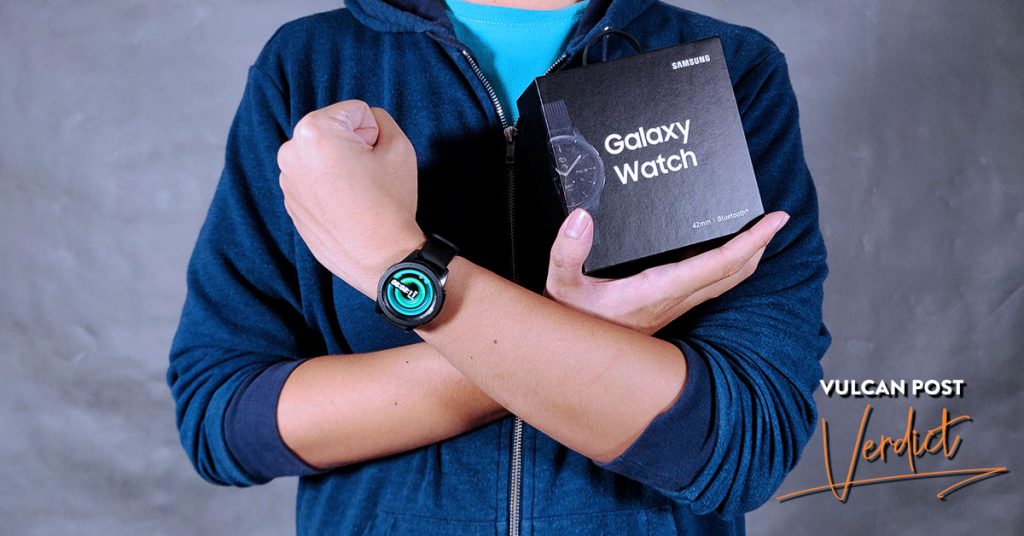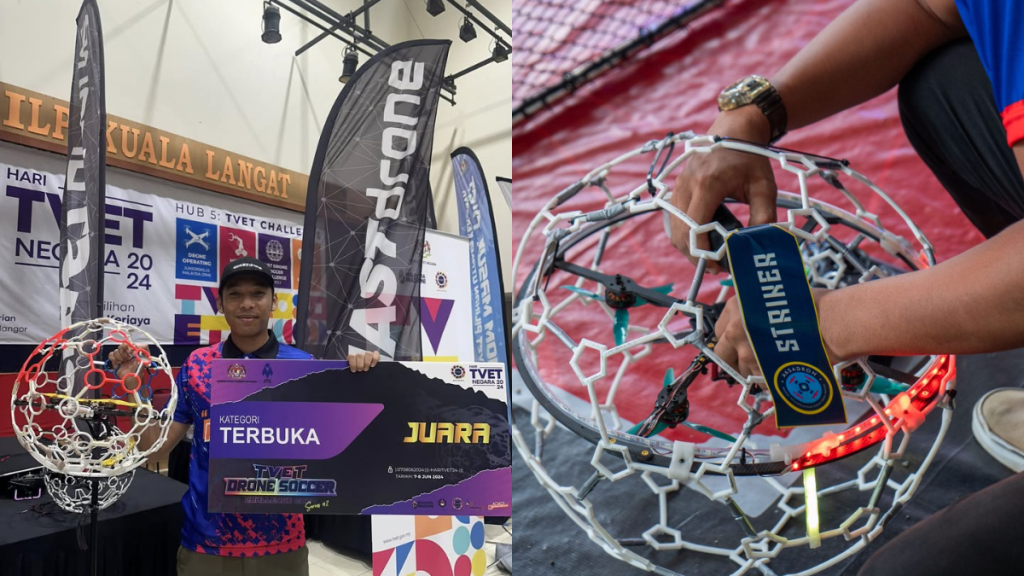- The Galaxy Watch is the latest smart wearable from Samsung, providing capabilities as a smartphone companion and as a fitness tracker.
- Prices are RM1,199/SGD398 for the 42mm model, and RM1,299/SGD448 for the 46mm model.
Recently, we got the opportunity to take Samsung’s latest and greatest wearable for a test drive. Coming as a successor to the fitness-centric Gear Sport, the new Galaxy Watch is yet another effort by the Korean giant to assert its presence in the growing smartwatch market.
Here’s what we thought of it.
Hardware
In the Galaxy Watch, Samsung has released a wearable that’s very much more of what they’ve already brought to the table so far.
 Externally, everything about the Galaxy Watch is reminiscent of the previous Gear Sport—it has the same interchangeable silicone strap, the signature rotating bezel for intuitive navigation, the two textured side buttons, and a vibrant display (available either in 42mm or 46mm sizes) with touch capabilities.
Externally, everything about the Galaxy Watch is reminiscent of the previous Gear Sport—it has the same interchangeable silicone strap, the signature rotating bezel for intuitive navigation, the two textured side buttons, and a vibrant display (available either in 42mm or 46mm sizes) with touch capabilities.

Everything is built solid, and on the wrist the weight hits the perfect spot of being just hefty enough to feel like a quality while at the same time light enough so it doesn’t feel intrusive as you go about your daily tasks.
 This also applies similarly to the silicone strap which is surprisingly breathable despite its material, making it comfortable enough if you want to wear it for long periods of exercise or sporting activity.
This also applies similarly to the silicone strap which is surprisingly breathable despite its material, making it comfortable enough if you want to wear it for long periods of exercise or sporting activity.
Aesthetically, the watch is a good fit for just about any occasion save for those where you’d need an actual dress watch. And with an IP68 water resistance rating, the watch is also good for situations where you might expect to get a little wet, just don’t expect to take it deep sea diving anytime soon.
Everyday Use
In terms of overall performance, the Galaxy Watch tries its best to be an everyday wearable that’s also a great smartphone companion.
Running on the Linux-based Tizen operating system (this one runs on a more recent version compared to the Gear Sport), the watch comes with a user interface that’s well thought-out and full of handy features.
Starting off, the Galaxy Watch is able to pair with both iOS and Android devices through Samsung’s Galaxy Wearable app through Bluetooth.
Here it seamlessly syncs things like contact info, calendar entries, and email, and makes it all easy to access through dedicated notifications screens on the watch face. In some cases, you can directly respond to these notifications through the watch.

For example, I was able to respond to WhatsApp messages by using the handwriting recognition function on screen, although I’d still prefer texting back using a full-sized keyboard.
I also found that navigating the Galaxy Watch was particularly enjoyable thanks to the rotating bezel and responsive touch screen, with movement through menus and features always snappy and intuitive.
It’s also worth nothing that the device comes with number of mini quirky features that are equal parts fun and useful, one example being the stress monitor that lets you know how hot and bothered you are based on your current heart rate.
As it turned out, this function ending up being a crowd-puller, with my office mates taking turns to measure and compare stress levels in the office (it wasn’t fun to find out I had the highest score, either).

On the subject of battery life, the Galaxy Watch does very well, lasting four days, sometimes stretching to four and a half on a single charge. On periods where you’d demand more active tracking for sporting activities, however, expect the battery life to last just short of four days.

Finally, the Galaxy Watch also has a few options when it comes to watch-specific apps, with the wearable app allowing you to download companion apps such as Spotify, Strava, and oddly enough, even a YouTube player app.
The Galaxy Apps store that lets you download these apps however, isn’t terribly responsive or well designed, so hopefully Samsung does something to improve it soon.

Fitness Tracking
In terms of fitness monitoring, the Galaxy Watch is actually very well-stocked when it comes to tracking options, with the complementary Samsung Health app allowing users to pick from a large amount of exercises and sporting activities such as running, cycling, badminton, and even arm curls. Most of them come with the option to activate a fitness coach that will guide you through an activity to reach a specific goal.

Cleverly enough, Samsung have also gone and included a feature where the Galaxy Watch automatically knows whenever you enter into a state of heightened physical activity, and starts tracking things like heart rate and lost calories. Once I went on a hike, the watch began tracking my physical metrics on its own, presumably by gauging my raised heart rate.

This auto tracking also applies to the sleep monitoring function, where the Galaxy Watch is able to automatically track your sleep activity and tell you whether or not you had a quality period of rest.
All this information is presented in well-organised detail through the free Samsung Health app, with each sporting activity and each cycle of sleep broken down into specifics such as calories burned, distance covered, average pace, and similar stats for workouts, and duration of REM sleep, deep sleep, and moments awake for sleep tracking.

On the topic of accuracy, the Galaxy Watch did fine for the most part. Heart rate detection was consistent nine times out of ten, and I identified step counts to be accurate save for some instances where detection was a little too sensitive (sudden movements sometimes registered as steps even if they weren’t). For those requiring absolutely accurate step tracking, this might be a bit of an issue.
Verdict
Overall, the Galaxy Watch is again, more of the same from what Samsung have released in the past. In fact when compared to the Gear Sport, the Galaxy Watch is pretty much identical except for a much improved battery and a more up-to-date operating system.
In truth, the Galaxy Watch isn’t exactly very exciting in terms of new functionality or breakthrough features, but yet at the core of it all, it still is still a very competent everyday wearable—which is what it was meant to be in the first place.
When you factor in a very good construction, a quick and easy-to-navigate feature set, and solid fitness tracking capabilities, I’d be hard pressed to not give the Galaxy Watch a recommendation for potential buyers looking for a solid all-rounder.
Here are the pros and cons at a glance:
|
Pros |
Cons |
| Solid construction and build materials | No breakthrough or killer feature |
| Lag-free operating system | Accompanying app needs a better app store |
| Well-rounded smartwatch and fitness tracker capabilities | Step tracking accuracy is sometimes too sensitive |
| Rotating bezel is still one of the best implementations of a smartwatch navigation tool |
- You can find out more about the Samsung Galaxy Watch on the official product page.
VP Verdict is a series where we personally try and test out products, services, fads, and apps. Want to suggest something else for us to try? Leave a comment here or send the suggestion into our Facebook page.














